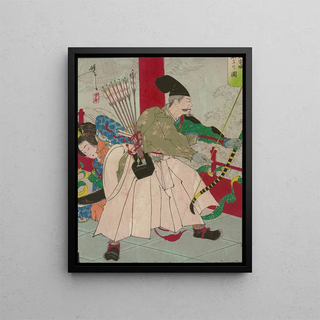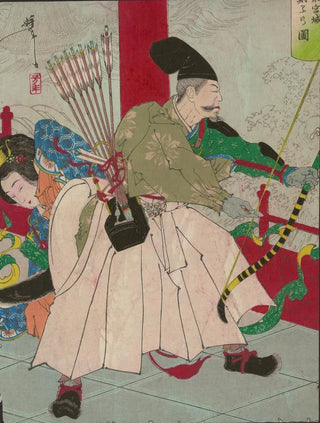Art print | Back - Tsukioka Yoshitoshi


View from behind

Frame (optional)
Tsukioka Yoshitoshi's "Dos" is a striking example of ukiyo-e art, a genre that flourished in Japan during the Edo period. This art print, both delicate and powerful, evokes a unique aesthetic sensibility rooted in tradition while bearing the mark of early modernity. Yoshitoshi, considered one of the last great masters of ukiyo-e, succeeds in capturing intense emotions through meticulously crafted compositions. "Dos" is not just an art print; it is an invitation to explore a world where every detail tells a story, where each color evokes a specific atmosphere. Through this art print, the viewer is transported into the rich and complex universe of Japanese art, where past and present meet with elegance.
Style and uniqueness of the art print
Yoshitoshi's style is distinguished by his bold use of colors and his ability to depict human figures with unparalleled expressiveness. In "Dos," the artist plays with light and shadow, creating a striking contrast that draws the eye and captivates the mind. The dynamic composition, where flowing lines and delicate shapes intertwine, reveals technical mastery that demonstrates the artist's innovation. Floral motifs and natural elements, often present in his works, add a poetic dimension, strengthening the connection between humans and their environment. This stylistic singularity, blending tradition and modernity, makes "Dos" a timeless art print, a piece that still resonates today with undeniable strength.
The artist and his influence
Tsukioka Yoshitoshi, born in 1839, is an iconic figure in Japanese art. His artistic journey, marked by social and cultural upheavals, allowed him to develop a unique style that combines the tradition of ukiyo-e with Western influences. Yoshitoshi adapted to the changes of his era while preserving the very essence of Japanese art. His works, often inspired by legends and historical narratives, demonstrate a deep understanding of the human psyche. As an innovator, he has

Matte finish

View from behind

Frame (optional)
Tsukioka Yoshitoshi's "Dos" is a striking example of ukiyo-e art, a genre that flourished in Japan during the Edo period. This art print, both delicate and powerful, evokes a unique aesthetic sensibility rooted in tradition while bearing the mark of early modernity. Yoshitoshi, considered one of the last great masters of ukiyo-e, succeeds in capturing intense emotions through meticulously crafted compositions. "Dos" is not just an art print; it is an invitation to explore a world where every detail tells a story, where each color evokes a specific atmosphere. Through this art print, the viewer is transported into the rich and complex universe of Japanese art, where past and present meet with elegance.
Style and uniqueness of the art print
Yoshitoshi's style is distinguished by his bold use of colors and his ability to depict human figures with unparalleled expressiveness. In "Dos," the artist plays with light and shadow, creating a striking contrast that draws the eye and captivates the mind. The dynamic composition, where flowing lines and delicate shapes intertwine, reveals technical mastery that demonstrates the artist's innovation. Floral motifs and natural elements, often present in his works, add a poetic dimension, strengthening the connection between humans and their environment. This stylistic singularity, blending tradition and modernity, makes "Dos" a timeless art print, a piece that still resonates today with undeniable strength.
The artist and his influence
Tsukioka Yoshitoshi, born in 1839, is an iconic figure in Japanese art. His artistic journey, marked by social and cultural upheavals, allowed him to develop a unique style that combines the tradition of ukiyo-e with Western influences. Yoshitoshi adapted to the changes of his era while preserving the very essence of Japanese art. His works, often inspired by legends and historical narratives, demonstrate a deep understanding of the human psyche. As an innovator, he has






